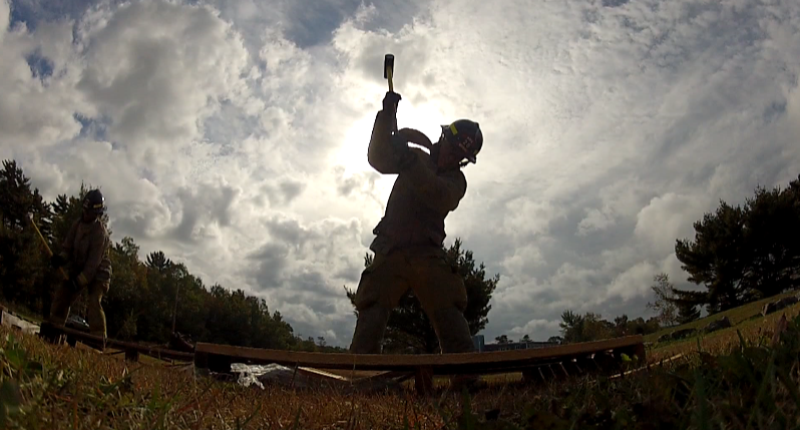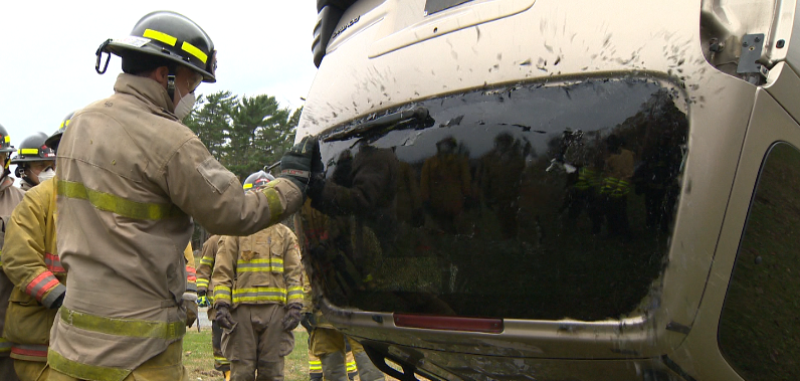WATCH ABOVE: Firefighting is a combination of skill, science and physical endurance. As Natasha Pace reports in our special series, the candidates enrolled at the Nova Scotia Firefighters School get some intense training.

HALIFAX – Students at the Nova Scotia Firefighter School have gone through a lot of training in the past few months, both inside the classroom and out.
“It’s going awesome, I love all the practical and even the theory isn’t bad because it’s all interesting stuff,” said Cristina Amaral, a firefighting student.
“It’s a lot of fun it’s a lot of hard work but I’m really enjoying it,” said Marcel West, also a student.
MORE: Read and watch the first part of our series on Firefighters School
One of the most important skills a firefighter will learn is how to forcibly enter a building. In order to do that, a number of specialized skills are taught, starting with how to break a lock. It’s an important skill that all students must master, but there’s much more to forcibly entering buildings and homes.
“We have to know how to break through a door, window, floor, wall,” Amaral told Global News. In order to learn that, mallets are used to break through wooden crates, mimicking a real life situation. It’s a task that proved to be a bit more challenging than Amaral originally thought.
“It’s hard,” she said with a laugh. “Some of the boards there are thicker plywood so it takes a lot of hits for me at least to get through.”
“All the big guys there, find some of the stuff easier than me but I have to be able to do it, so I’ll find a way,” she added.
Students must also learn how to operate a chainsaw, a tool firefighters often use for cutting into walls, floors during an emergency situation.
One of the most physical parts of forcible entry training is learning to breach inward and outward facing doors. A skill that’s a favourite for many students.
“I really like breaching doors, that’s something I can’t wait to do in the future, knocking doors down,” said student Gerald Parris
After some direction from instructors, students are on their own. The training is complicated, but Marcel West says it’s important to learn the proper way to do things from career firefighters.
“There’s always the way they show us in the book and then the little real life situations that vary and little tricks that make it easier,” he said.
But fighting fires is only one part of the job the students are training for.
“Fire is really only a small part of what we do. We run a lot of calls on highways, high speed collisions that sort of thing,” said Lynelle Vetsch, an instructor at the school.
Students must learn vehicle extraction skills as part of their training. Whether it be stabilizing a vehicle that just crashed, or breaking a window to get inside.
At the mid-way point of the course, only one student has dropped out.
“We have 27 of 28, 11 weeks in so we’re quite proud of that,” Vetsch said. “This group has gelled well, they’re working together well as a team.”
Being part of a team is critical in this business. Students are assigned a buddy on the first day of classes, someone they’re never allowed to be without. It’s a way to re-enforce what it’s like to actually work in the field as a firefighter.
“If you have a problem with your air supply, if you fall through the floor, you need a buddy to back you up if you need that help,” Vetsch said.
Firefighting is a very male dominated field. Out of nearly thirty students, only three are women.
“We’re still trying to get our numbers up with women, we’d love to hit that 50% mark to better represent society, but it’s a slow change,” she said Global News.
Next, students will tackle one of the hardest parts of the training; a 24 hour shift, where everything they have been taught in the past few months is put into play.
Watch the final part of our series on the firefighters’ school, Friday at 6 p.m. Atlantic Time on Global News.





Comments